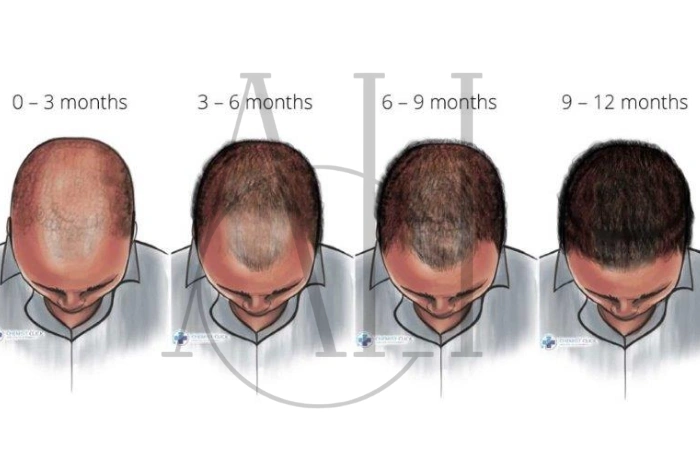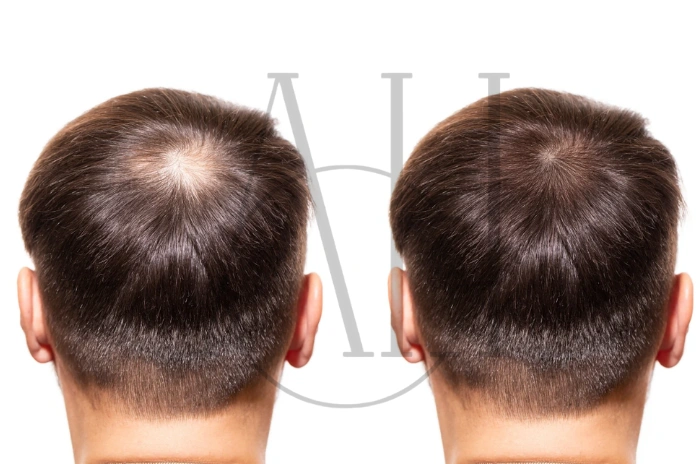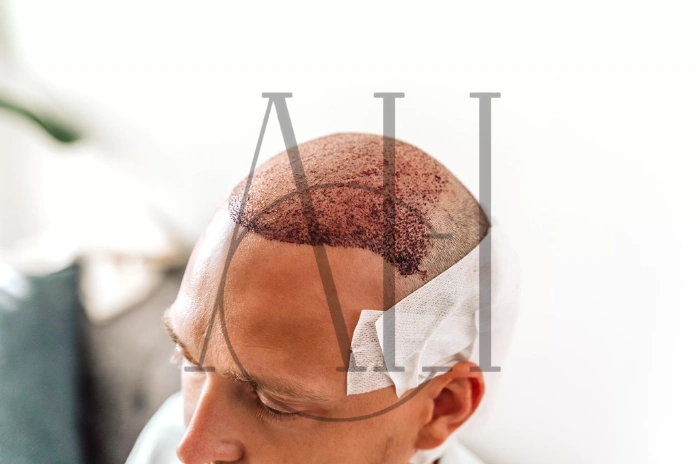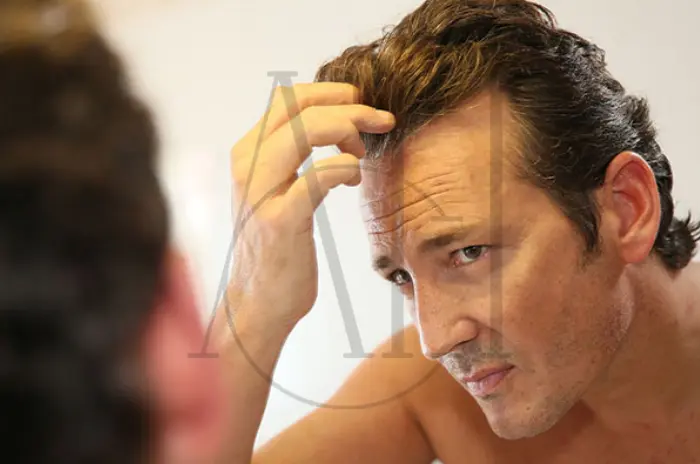Hair loss affects millions of men worldwide, making finasteride before and after results one of the most searched topics in hair restoration. This FDA-approved medication has become the gold standard for treating male pattern baldness, offering hope to those experiencing androgenetic alopecia.
Finasteride results can vary significantly between individuals, but understanding the typical timeline and expectations helps set realistic goals. This comprehensive guide examines real patient outcomes, treatment phases, and important considerations for anyone considering this hair loss solution.
The journey with finasteride for hair loss requires patience and realistic expectations. While some men notice improvements within months, the full benefits typically emerge after consistent use over 12-18 months. Understanding what to expect during each phase helps maintain motivation throughout the treatment process.
Table of Contents
ToggleHow Finasteride Works as a Hair Loss Treatment
Finasteride operates by targeting the root cause of male pattern baldness at the hormonal level. The medication works as a 5-alpha-reductase inhibitor, specifically blocking the Type II enzyme that converts testosterone into dihydrotestosterone (DHT). This precise mechanism makes finasteride one of the most scientifically-backed treatments available today.
The DHT Connection:
- DHT is the primary hormone responsible for hair follicle miniaturization
- It binds to hair follicles, causing them to shrink progressively
- Reduced follicle size leads to thinner, weaker hair strands
- Eventually, follicles stop producing hair altogether
- DHT sensitivity varies among individuals due to genetic factors
The Hair Growth Cycle Impact: Understanding how finasteride affects the natural hair growth cycle is crucial for patient expectations. Normal hair follicles go through three phases: anagen (growth), catagen (transition), and telogen (resting). DHT shortens the anagen phase dramatically, sometimes reducing it from 3-6 years to just months. Finasteride helps restore normal cycle duration by reducing DHT levels by approximately 60-70%, allowing hair follicles to maintain their natural growth timeline.
By reducing DHT levels significantly, finasteride helps preserve existing hair follicles and can even reverse some miniaturization in the early stages of hair loss. This dual action of prevention and restoration makes it particularly effective for men in the initial stages of androgenetic alopecia.
| Mechanism | Effect | Timeline |
|---|---|---|
| DHT Reduction | 60-70% decrease | 2-4 weeks |
| Hair Follicle Stabilization | Stops further miniaturization | 3-6 months |
| Hair Regrowth | Visible improvement | 6-12 months |
Real Patient Finasteride Before and After Photos
Finasteride photos from real patients provide valuable insights into the medication’s effectiveness across different stages of hair loss. Clinical studies consistently show that approximately 83% of men maintain their hair count, while 65% experience some degree of regrowth after two years of treatment.
Patient documentation reveals that finasteride effectiveness is most pronounced in the crown area, where many men see visible thickening and density improvement. The hairline typically shows more modest improvements, though stabilization of further recession is common.
Real-world finasteride before and after comparisons demonstrate that younger men with recent hair loss tend to achieve better results than those with advanced balding. Men in their 20s and 30s often experience more dramatic transformations, particularly when treatment begins within the first five years of noticeable thinning.
Photographic Evidence Categories
- Crown restoration: 70-80% of patients show improvement
- Vertex thickening: Most common area for visible regrowth
- Hairline stabilization: Prevents further recession in 90% of cases
- Overall density: Gradual improvement over 12-24 months
The Typical Finasteride Results Timeline
Understanding the finasteride timeline helps manage expectations during treatment. The medication works by blocking DHT production, but hair follicles need time to recover and produce healthier strands.
How long does finasteride take to work varies by individual, but most men follow a predictable pattern. Initial shedding often occurs within the first 2-3 months, followed by stabilization, then gradual improvement.
The finasteride results timeline typically unfolds in distinct phases:
Months 1-3: Initial Phase
- Possible temporary shedding
- DHT levels decrease by 70%
- No visible improvements yet
- Some men experience initial side effects
Months 4-6: Stabilization Phase
- Shedding typically stops
- Hair loss stabilizes
- First signs of thickness may appear
- Side effects often resolve
Months 7-12: Improvement Phase
- Gradual density increases
- Existing hairs become thicker
- Crown area shows first improvements
- Finasteride hair growth becomes noticeable
Finasteride Dosage for Hair Loss Treatment
The standard finasteride 1mg daily dose has been extensively studied and proven effective for male pattern baldness treatment. This dosage, marketed as Propecia, represents the optimal balance between efficacy and safety.
Finasteride 1mg effectively reduces scalp DHT levels by approximately 70%, which is sufficient to halt hair loss progression in most men. Higher doses do not provide proportionally better results but may increase the risk of side effects.
Medical professionals rarely recommend dosage adjustments, as the 1mg formulation has demonstrated consistent results across diverse patient populations. Some doctors may suggest taking the medication at the same time daily to maintain steady blood levels.
Dosage Guidelines
- Standard dose: 1mg once daily
- Timing: Same time each day recommended
- Duration: Continuous use required for maintained results
- Missed doses: Take as soon as remembered, skip if near next dose

Early Months on Finasteride: What You May Notice
The initial months of finasteride treatment can be challenging as the medication begins working. Many men experience what’s known as the “finasteride shed,” where existing weak hairs fall out to make room for stronger ones.
Finasteride reddit discussions frequently mention this early shedding phase, which affects approximately 25% of users. This temporary increase in hair loss typically lasts 2-8 weeks and indicates the medication is working effectively.
During early treatment, some men notice changes in hair texture before seeing density improvements. Hairs may become thicker, shinier, and more resilient as DHT levels decrease and follicles begin recovering.
Common Early Experiences
- Temporary increase in shedding (weeks 2-8)
- Subtle changes in hair texture
- Gradual reduction in daily hair loss
- Stabilization of hairline recession
Potential Finasteride Side Effects to Consider
Finasteride side effects occur in a small percentage of users and typically resolve with continued use or discontinuation. Understanding these potential effects helps make informed treatment decisions.
The most commonly reported side effects affect sexual function, occurring in approximately 2-4% of men taking finasteride for hair loss. These effects are generally reversible and often improve even with continued treatment.
Clinical trials show that most side effects are mild and temporary. The majority of men tolerate the medication well, with less than 2% discontinuing treatment due to adverse effects.
Side Effect Categories
Sexual Effects (2-4% of users)
- Decreased libido
- Erectile dysfunction
- Reduced ejaculate volume
Physical Effects (Less than 1%)
- Breast tenderness
- Depression or mood changes
- Allergic reactions (rare)
Cognitive Effects (Rare)
- Memory issues (controversial)
- Brain fog (reported by some users)
Finasteride Results Timeline From 4 to 18 Months
The extended finasteride results timeline from 4-18 months represents the period when most significant improvements occur. Does finasteride work becomes clearly apparent during this phase as cumulative benefits manifest.
Month 4-6 Results: Hair shedding typically stops completely, and the first signs of improvement appear. Many men notice that their hair feels thicker when shampooing or styling. The crown area often shows the earliest signs of recovery.
Month 7-12 Results:
Visible improvements become apparent to both users and others. Finasteride hair growth is most noticeable in the crown and vertex areas. Existing hairs continue to thicken, and new terminal hairs may begin emerging.
Month 13-18 Results: Peak results typically occur during this period. Men who respond well to treatment see their maximum benefit, with continued gradual improvements possible beyond 18 months.
Progressive Improvements by Phase
| Timeline | Crown Improvement | Hairline Changes | Overall Density |
|---|---|---|---|
| 4-6 months | Slight thickening | Stabilization | 5-10% increase |
| 7-12 months | Moderate growth | Minimal improvement | 15-25% increase |
| 13-18 months | Maximum benefit | Possible thickening | 25-35% increase |
The male pattern baldness treatment shows continued benefits in long-term studies, with many men maintaining or even improving their results after two years of consistent use.
Who Should and Should Not Take Finasteride
Finasteride is not suitable for everyone, and proper patient selection is crucial for both safety and effectiveness.
Ideal Candidates:
- Men aged 18-65 with male pattern baldness
- Early to moderate hair loss stages
- Good overall health status
- Realistic expectations about treatment outcomes
- Commitment to long-term therapy
Contraindications:
- Women (especially pregnant or breastfeeding)
- Children and adolescents
- Men with liver disease
- Those with hypersensitivity to finasteride
- Patients with certain prostate conditions
Special Considerations: Men planning to have children should discuss timing with their healthcare provider, as finasteride can temporarily affect sperm quality. Regular prostate monitoring may be recommended for men over 50, as finasteride can affect PSA levels.
How Finasteride Treats Androgenetic Alopecia
Androgenetic alopecia, commonly known as male pattern baldness, follows a predictable pattern of hair loss that finasteride can effectively address.
The Progressive Pattern: Androgenetic alopecia typically begins with hairline recession and crown thinning, eventually progressing to more extensive hair loss. Finasteride interrupts this progression by:
- Blocking DHT production at the follicular level
- Preventing further follicle miniaturization
- Allowing dormant follicles to resume normal growth cycles
- Extending the anagen (growth) phase of hair development
Treatment Success Factors:
- Early intervention provides best outcomes
- Consistency in medication adherence
- Realistic timeline expectations
- Professional monitoring and support
- Combination with complementary treatments when appropriate
FAQ :What to Expect From Finasteride Treatment Results (Before and After)
What should I expect during early months?
Initial shedding is common during the first 2-8 weeks, followed by gradual stabilization and eventual improvement in hair density and thickness.
Can finasteride cause any serious side effects?
Serious side effects are rare, with most men experiencing no adverse effects; sexual side effects occur in 2-4% of users and are typically reversible.
How long before finasteride results are noticeable?
Most men see initial improvements between 4-6 months, with significant finasteride results becoming apparent after 12-18 months of consistent use.
What is the recommended dosage for hair loss?
The standard recommended dosage is finasteride 1mg taken once daily at the same time each day for optimal effectiveness.




